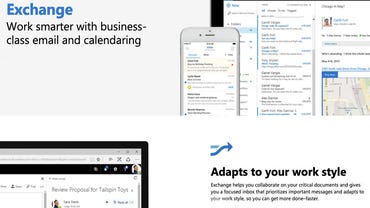
So, you think chat apps, mobile messaging, texting, and Facebook will kill email? Think again. The number of email users worldwide has been steadily growing year by year. In 2017, there were 269 billion emails sent each day. By 2019, that had grown to almost 294 billion. And by 2023, Statistica estimates, we’ll be sending more than 347 billion messages a day.
Clearly, email is still a force for communication. Suppose, if you want to go beyond the free email offerings, present a professional email address, and have some level of control over your corporate email communications. In that case, you’ll want to sign up with an email hosting provider.
In this article, we present you with a number of excellent email hosting providers who specialize in email and office productivity. Then, we’ll introduce you to some web hosts that also offer solid email hosting packages, in case you want to contract for web hosting and email from the same vendor.
Traditional email-focused hosting providers
Here are some of the top email-focused hosting providers. It’s probably no surprise we kick off with Google’s Workspace (formerly G Suite) and Microsoft’s Microsoft 365 and Exchange. But they’re not the only games in town. Keep reading to see some alternative options if you don’t want to live entirely in Microsoft’s or Google’s ecosystem.
- Your domain name: Yes.
- Mailbox size: 30GB, 2TB, and 5TB.
- Spam and virus protection: Yes.
- Aliases: Yes.
- 24/7 support: Chat, ticket, or phone.
- Archiving and storage: Depending on the plan.
It was really a coin toss whether we kicked this email provider list off with Workspace or Microsoft 365. Both are excellent. Workspace integrates an enterprise-level Gmail management interface with Google Docs, Meet, Calendar, and a wide variety of other tools.
Must read:
Pricing is a lot simpler to understand with Workspace than Office 365. Microsoft offers a wide variety of plans and options that also integrate into its other licensing pricing structures. Gmail gives you just three simple choices: $6 per month, $12 per month, or $18 per month per user, depending on what enterprise management features you want.
Unfortunately, when G Suite transitioned to Workspace, the non-enterprise plans lost their unlimited storage. While G Suite was compelling on its own, the unlimited storage made it a must-have. Removal of that capability has reduced Workspace’s appeal, but it still does a great job of mail management.
More details:
Here’s a special tip: If you want to get support from Google, get a Workspace subscription. As a Workspace customer, I’ve been quite pleased with the level of support provided.
- Your domain name: Yes.
- Mailbox size: 50GB and up.
- Spam and virus protection: Yes.
- Aliases: Yes.
- 24/7 support: Chat, ticket, or phone.
- Archiving and storage: Depending on the plan.
Office 365 is becoming Microsoft 365 because… why not? Except, not entirely. Home users will still get Office 365. This is a fabulous product, but I swear Microsoft goes out of its way to confuse folks with its branding changes. It’s like it’s a hobby or something.
That said, Microsoft 365 is all the Office desktop apps, all of the Office online apps, Microsoft Teams, all the benefits of Exchange, calendaring, mobile apps, and more. I also have a Microsoft 365 subscription, mostly for the Office apps. That said, you can not go wrong with Office, er, Microsoft 365. And if you love your Outlook email client, you’ll feel right at home with Microsoft 365.
Let Microsoft run your Exchange server
- Your domain name: Yes.
- Mailbox size: 50GB and up.
- Spam and virus protection: Yes.
- Aliases: Yes.
- 24/7 support: Chat, ticket, or phone.
- Archiving and storage: Depending on the plan.
Trust me when I tell you that running Exchange in-house is a big job. Way back in the day, I almost lost everything when my (admittedly misconfigured) Exchange server crashed hard due to a failed hard drive. Even though I thought I had backups, it took me 13 days to get things back up and running.
On the other hand, Exchange has been having severe security troubles of late. That said, if I were running Exchange, I’d much rather have Microsoft responsible for making it safe than having to deal with it all myself.
Must read:
I can’t tell you what I would have given to be freed from that responsibility. That was before Microsoft had Azure and Exchange Online. But now, all you need to do is pay a few bucks a month, and Microsoft will manage your Exchange operations and deliver all your email messages for you. To be fair, I’d recommend adding a few bucks and going to the Office 365 Business Premium plan I showed you earlier, but still, what I would have given for this service back in the day!
Amazon’s AWS service for mail management
- Your domain name: Yes.
- Mailbox size: 50GB.
- Spam and virus protection: Yes.
- Aliases: Yes.
- 24/7 support: Chat, ticket, or phone.
- Archiving and storage: Added fee.
So, let’s be clear. You’re looking at email hosted on AWS. That’s pretty much the gold standard of cloud environments, on a rarified level that coexists only with Google and Microsoft Azure. Because it’s an AWS-based service, WorkMail integrates with all the other AWS services, allowing you to build out a relatively rich cloud-based, customized infrastructure.
If you’re a small company, just trying to set up a few email boxes, I wouldn’t necessarily go with WorkMail. AWS can be a little challenging to get your head around. But if you’re building out a cloud-based corporate infrastructure where you need a lot of flexibility, security, and Active Directory integration, WorkMail is definitely a viable and proven solution.
Microsoft 365, Exchange, and SMTP email
- Your domain name: Yes
- Mailbox size: Unlimited
- Spam and virus protection: Yes
- Aliases: Yes
- 24/7 support: Chat, ticket, or phone
- Archiving and storage: Added fee
Rackspace is one of the original cloud infrastructure providers. Today, the company offers a wide range of infrastructure-as-a-service options, including full Exchange hosting, Microsoft 365 management, and traditional email hosting.
The company offers migration assistance from other hosts, a large team of MCSA certified staff, and the ability to support an existing Microsoft Enterprise Agreement.
Exchange, SMTP, and email servers
- Your domain name: Yes.
- Mailbox size: 10GB or 25GB.
- Spam and virus protection: Yes.
- Aliases: Yes.
- 24/7 support: Chat, ticket, or phone.
- Archiving and storage: Added fee.
Greatmail offers a cloud-based email hosting service with both a web-based client and traditional POP3/IMAP clients. The company offers basic email plans with just email, as well as a groupware plan that includes mail, calendar, and contact syncing.
If you’re interested in bulk-sending email, the company does offer an SMTP-sending service for “responsible senders.” This service includes an outbound relay service for transactional messages, email marketing campaigns, newsletters, and other applications.
The company also offers dedicated email servers. Greatmail’s Exchange hosting is a traditional offering, but it also has a plan that allows a mix of both POP3 and Exchange clients to reduce Exchange per-user licensing costs.
Lots of integrated applications to work alongside mail
Zoho is another one of those companies that provides a lot of offerings. However, instead of offering web hosting, Zoho offers a wide range of cloud-based apps. It’s kind of like G Suite on steroids….







